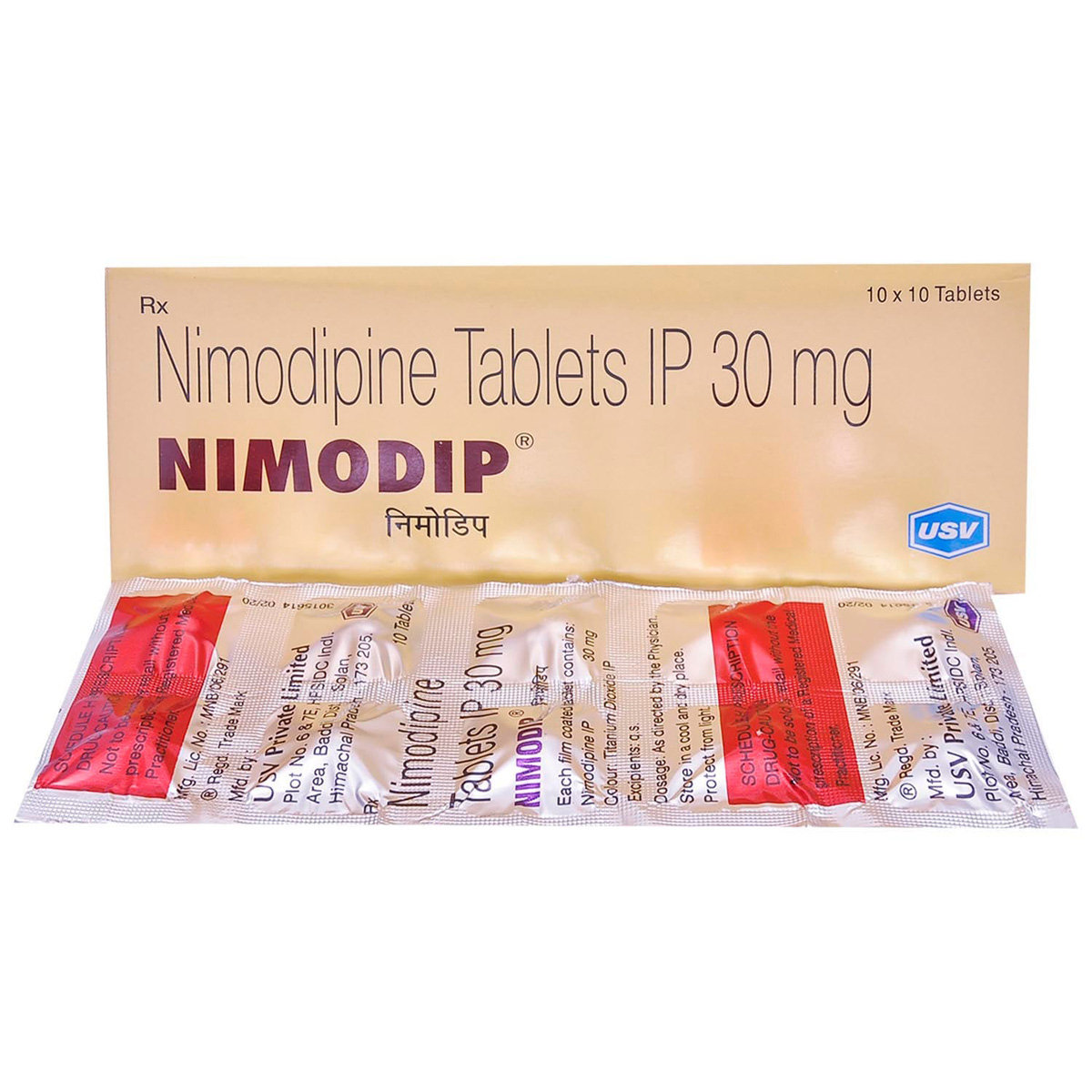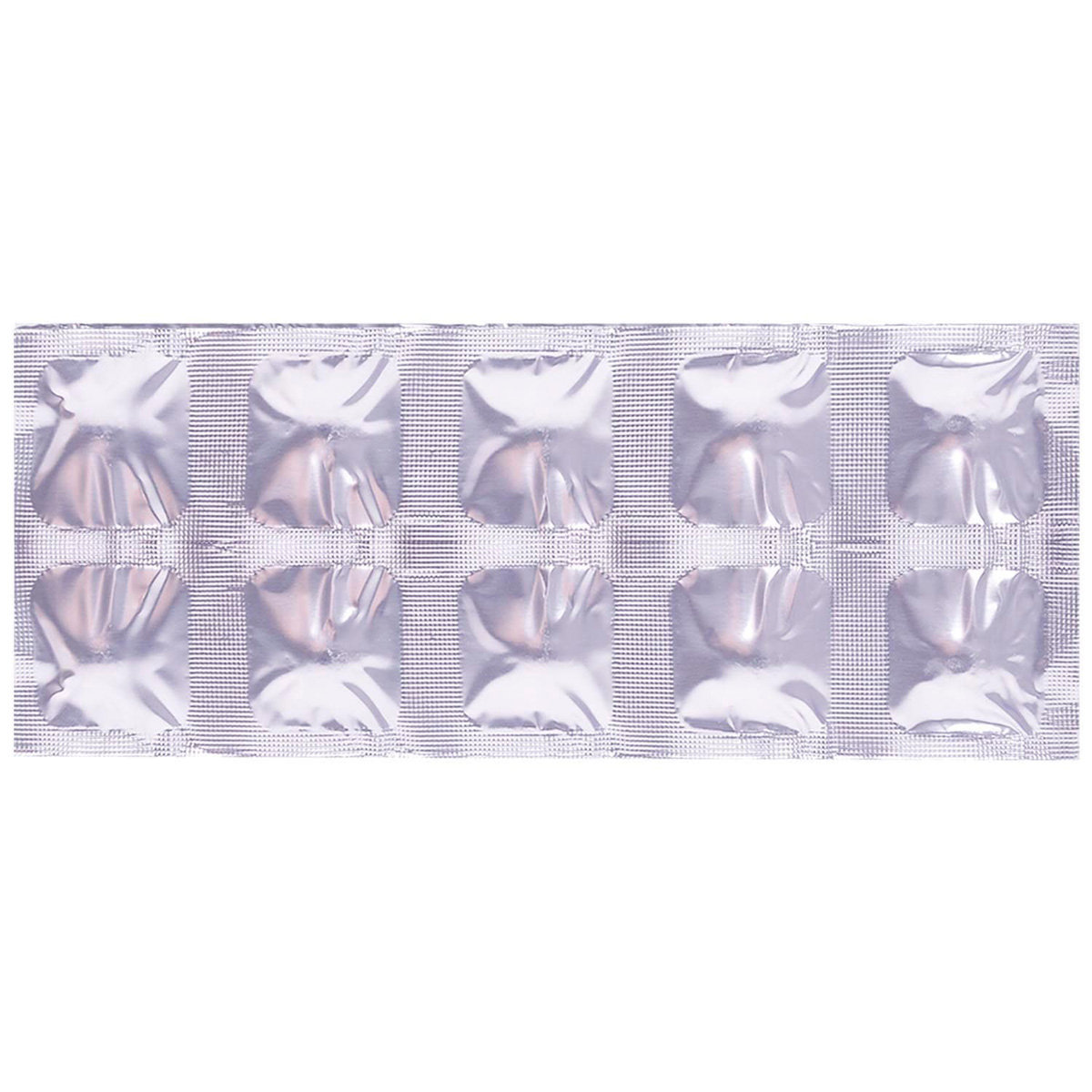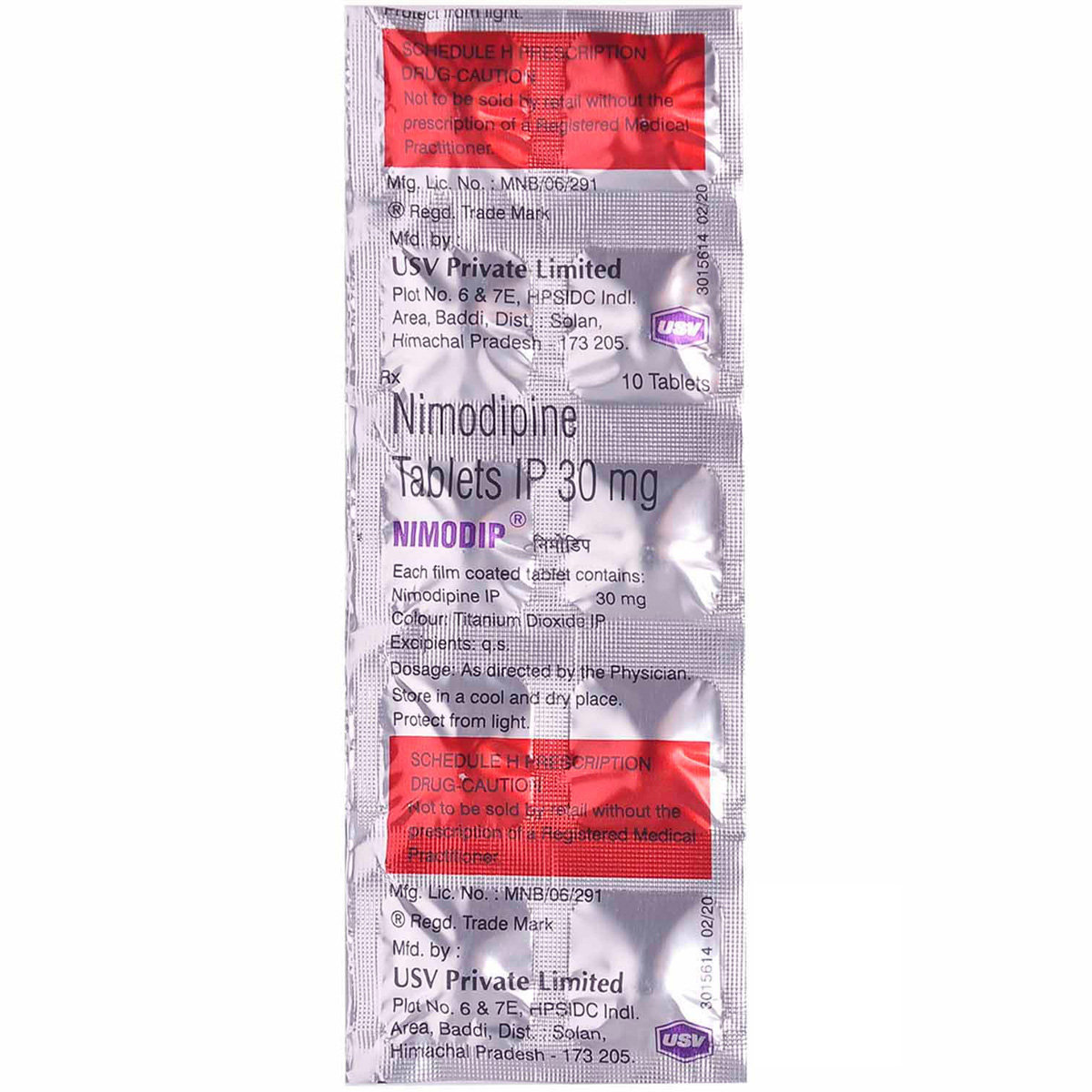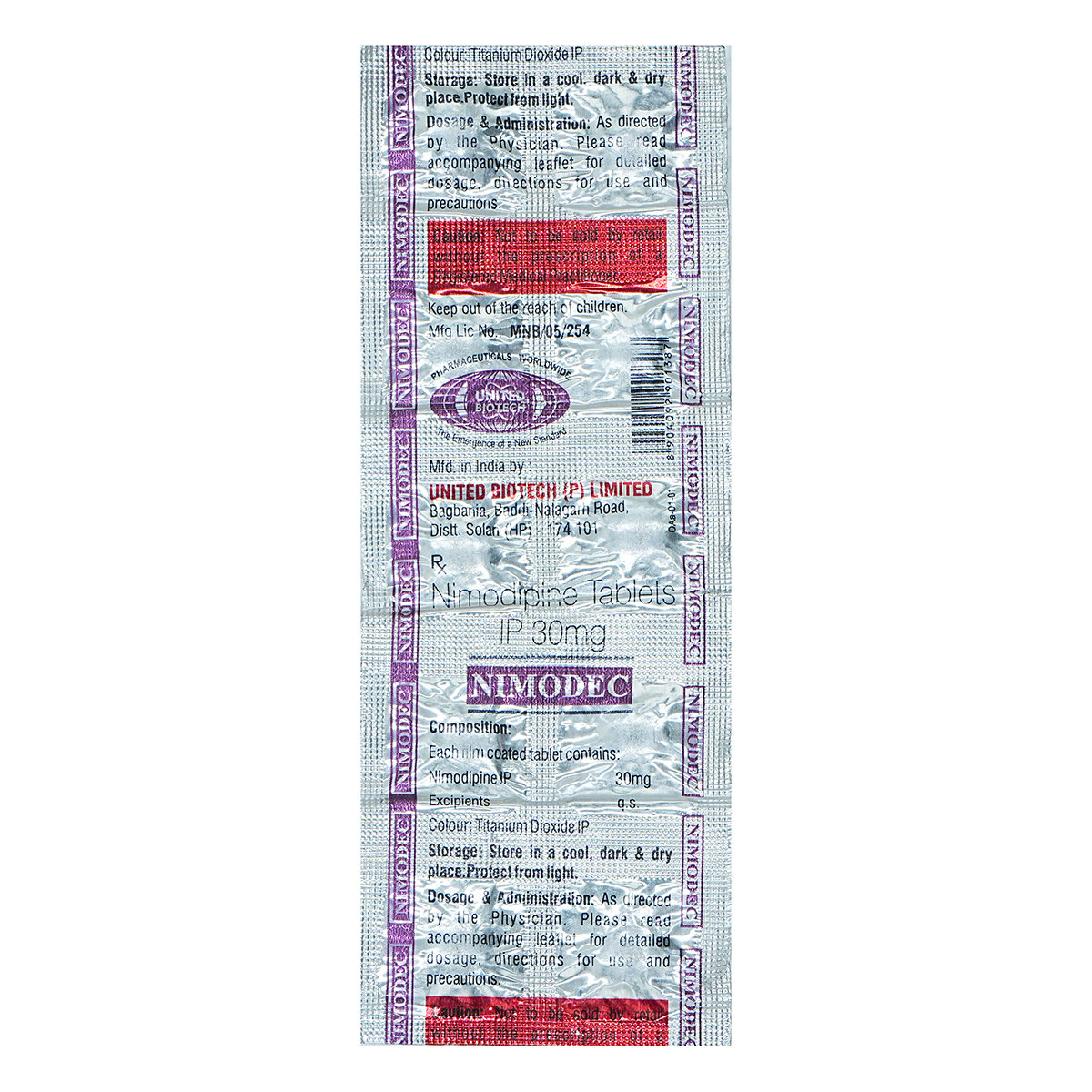Nimodip Tablet





MRP ₹264.5
(Inclusive of all Taxes)
₹39.7 Cashback (15%)
know your delivery time
Provide Delivery Location
Composition :
Manufacturer/Marketer :
Consume Type :
Expires on or after :
Return Policy :

Secure Payment

Trusted by 8 Crore Indians

Genuine Products
Therapeutic Class
Country of origin
Manufacturer/Marketer address
Author Details
We provide you with authentic, trustworthy and relevant information
Disclaimer
Alcohol
Safe if prescribed
Avoid alcohol consumption while taking Nimodip Tablet as it might cause increased dizziness.
Pregnancy
Consult your doctor
Nimodip Tablet belongs to pregnancy category C. Please consult your doctor if you have any concerns regarding this, your doctor will prescribe Nimodip Tablet only if the benefits outweigh the risks.
Breast Feeding
Consult your doctor
Avoid breastfeeding while on treatment with Nimodip Tablet .
Driving
Safe if prescribed
Nimodip Tablet may cause dizziness and decreased alertness. Drive and operate machinery only if you are alert.
Liver
Consult your doctor
Dose adjustment may be needed. Nimodip Tablet should be used with caution in patients with liver impairment/liver disease. Please consult your doctor if you have a liver impairment or any concerns regarding this.
Kidney
Consult your doctor
Dose adjustment may be needed. Please consult your doctor if you have kidney impairment or any concerns regarding this.
Children
Safe if prescribed
Nimodip Tablet is not recommended for children below 18 years as safety and effectiveness have not been established.
Product Substitutes
About Nimodip Tablet
Nimodip Tablet belongs to the group of medicines called 'calcium channel blockers' used to prevent brain function changes after subarachnoid haemorrhage (bleeding around the brain) due to stroke or trauma. Subarachnoid haemorrhage is bleeding around the brain, usually bleeding from an aneurysm (a weakened area in a blood vessel).
Nimodip Tablet contains ‘Nimodipine’ that relaxes the smooth muscles of the small blood vessels in the brain, allowing narrowed blood vessels to open up, making it easier for the blood to flow. This helps increase blood flow & circulation, reduces blood pressure, prevents spasms in blood vessels and lowers the risk of damage caused by insufficient blood flow to the brain after bleeding.
You are advised to take Nimodip Tablet for as long as your doctor has prescribed it for you depending on your medical condition. In some cases, you may experience common side-effects such as nausea, stomach upset, headache, light-headedness, irregular heartbeat and muscle pain. Most of these side-effects do not require medical attention and will resolve gradually over time. However, you are advised to talk to your doctor if the side-effects persist or worsen.
Consult your doctor if you are pregnant. Avoid breastfeeding while taking Nimodip Tablet . Drive or operate machinery only if you are alert as Nimodip Tablet may cause dizziness and decreased alertness. Avoid alcohol consumption while taking Nimodip Tablet as it might cause increased dizziness. Nimodip Tablet is not recommended for children below 18 years of age as safety and effectiveness have not been established.
Uses of Nimodip Tablet
Medicinal Benefits Mweb
Key Benefits
Nimodip Tablet belongs to the group of medicines called calcium channel blockers used to prevent brain function changes after subarachnoid haemorrhage (bleeding around the brain). Nimodip Tablet relaxes the smooth muscles of the small blood vessels in the brain, allowing narrowed blood vessels to open up, making it easier for the blood to flow. This helps increase blood flow and circulation, reduces blood pressure, prevents spasms in blood vessels and lowers the risk of damage caused by insufficient blood flow to the brain after bleeding.
Directions for Use
Side Effects of Nimodip Tablet
- Nausea
- Stomach upset
- Headache
- Light-headedness
- Irregular heartbeat
- Muscle pain
- Hypotension
Drug Warnings
Do not take Nimodip Tablet if you are allergic to any of its components, if you have had a heart attack in the last month or have angina. Inform your doctor if you have/had a head injury, severely raised pressure in the skull, low blood pressure, alcoholism, kidney/liver problems or if you are on a sodium diet. Consult your doctor if you are pregnant. Avoid breastfeeding while taking Nimodip Tablet . Drive or operate machinery only if you are alert as Nimodip Tablet may cause dizziness and decreased alertness. Avoid alcohol consumption while taking Nimodip Tablet as it might cause increased dizziness. Nimodip Tablet is not recommended for children below 18 years as safety and effectiveness have not been established.
Drug-Drug Interactions
Drug-Drug Interactions
Login/Sign Up
When Telaprevir is taken with Nimodip Tablet, it can increase the risk of side effects.
How to manage the interaction:
Taking Nimodip Tablet with Telaprevir is not recommended, as it can possibly result in an interaction, but it can be taken if your doctor has advised it. However, consult the doctor if you experience any symptoms such as irregular heart rhythm, swelling, and low blood pressure. Do not discontinue any medications without a doctor's advice.
When Mibefradil is taken with Nimodip Tablet, it can increase the risk of side effects.
How to manage the interaction:
Taking Nimodip Tablet with Mibefradil is not recommended, as it can possibly result in an interaction, but it can be taken if your doctor has advised it. However, consult the doctor if you experience any symptoms such as irregular heart rhythm, swelling, and low blood pressure. Do not discontinue any medications without consulting the doctor.
Taking Nimodip Tablet with Ritonavir can increase the blood levels of ritonavir, which may lead to increased side effects.
How to manage the interaction:
Taking Nimodip Tablet with Ritonavir is not recommended as it can possibly result in an interaction, it can be taken if your doctor has advised it. However, if you experience irregular heart rhythm, swelling, and lightheadedness, contact a doctor. Do not discontinue any medications without consulting a doctor.
When Nimodip Tablet is taken with Indinavir, it can increase the risk of side effects.
How to manage the interaction:
Taking Nimodip Tablet with Indinavir is not recommended, as it can possibly result in an interaction, but it can be taken if your doctor has advised it. However, consult the doctor if you experience irregular heart rhythm, swelling. Do not discontinue any medications without a doctor's advice.
When Boceprevir is taken with Nimodip Tablet, it can increase the risk of side effects.
How to manage the interaction:
Taking Nimodip Tablet with Boceprevir is not recommended, as it can possibly result in an interaction, but it can be taken if your doctor has advised it. However, consult the doctor if you experience- irregular heart rhythm, swelling, and low blood pressure. Do not discontinue any medications without a doctor's advice.
When Nimodip Tablet is taken with Carbamazepine, it may decrease the blood levels of Nimodip Tablet, which may make Nimodip Tablet less effective in treating your condition.
How to manage the interaction:
Taking Nimodip Tablet with Carbamazepine is not recommended, but it can be taken if prescribed by the doctor. However, if you experience any unusual symptoms, consult the doctor. Do not discontinue any medications without a doctor's advice.
When Nimodip Tablet is taken with Telithromycin, it can increase the risk of side effects.
How to manage the interaction:
Taking Nimodip Tablet with Telithromycin is not recommended, as it can possibly result in an interaction, but it can be taken if your doctor has advised it. However, consult the doctor if you experience any symptoms such as irregular heart rhythm, swelling, and low blood pressure.
When Nimodip Tablet is taken with Clarithromycin, it can increase the risk of side effects.
How to manage the interaction:
Co-administration of Clarithromycin and Nimodip Tablet is not recommended as it can lead to an interaction, it can be taken if advised by a doctor. However, if you experience any symptoms like irregular heart rhythm, swelling, and low blood pressure, consult a doctor immediately. Do not stop using any medications without a doctor's advice.
When Nimodip Tablet is taken with Cobicistat, it can increase the risk of side effects.
How to manage the interaction:
Taking Nimodip Tablet with Cobicistat is not recommended, as it can possibly result in an interaction, but it can be taken if your doctor has advised it. However, consult the doctor if you experience irregular heart rhythm, swelling, and low blood pressure. Do not discontinue any medications without consulting the doctor.
Using Nimodip Tablet together with Voriconazole may significantly increase the risk of serous side effects.
How to manage the interaction:
Taking Nimodip Tablet with Voriconazole is not recommended, as it may lead to an interaction, but it can be taken if prescribed by the doctor. However, if you experience symptoms such as irregular heart rhythm, swelling, and low blood pressure, consult the doctor. Do not discontinue any medication without consulting a doctor.
Drug-Food Interactions
Drug-Food Interactions
Login/Sign Up
Grapefruit Juice, Grapefruit
How to manage the interaction:
The blood levels and effects of Nimodip Tablet can be greatly increased by grapefruit juice. The possibility of experiencing negative symptoms like headaches, low blood pressure, irregular pulse, swelling, and fluid retention may increase. Avoid consumption of grapefruit and grapefruit juice during Nimodip Tablet treatment.
Drug-Diseases Interactions
Drug-Diseases Interactions
Login/Sign Up
Drug-Drug Interactions Checker List
- NIFEDIPINE
- DILTIAZEM
- ATENOLOL
- PROPRANOLOL
- VERAMAPIL
- METHYLDOPA
- CIMETIDINE
- PHENOBARBITONE
- PHENYTOIN
- CARBAMAZEPINE
- SODIUM VALPROATE
- FLUOXETINE
- NEFAZODONE
- FUROSEMIDE
- INDINAVIR
- RITONAVIR
- NELFINAVIR
- SAQUINAVIR
- KETOCONAZOLE
- QUINUPRISTIN+DALFOPRISTIN
Habit Forming
Special Advise
- Regular monitoring of blood pressure levels and heart rate is advised.
- Your doctor may advise regular liver function tests, and blood tests to check your progress.
Diet & Lifestyle Advise
- Avoid smoking and alcohol consumption.
- Maintain a healthy weight with proper diet and exercise.
- Include foods such as whole-grain bread, low-fat dairy products, lean meat, beans and fish.
- Exercise as directed by the physician. It helps in lowering blood pressure, cholesterol, blood sugar and weight.
- Manage stress with meditation, music or deep breathing.
All Substitutes & Brand Comparisons
RX
Out of StockVasotop 30mg Tablet
Cipla Ltd
₹60
(₹5.4 per unit)
77% CHEAPERRX
Out of StockNimovas 30mg Tablet
₹134
(₹12.06 per unit)
49% CHEAPERRX
Nimodec 30 mg Tablet 10's
United Biotech Pvt Ltd
₹145
(₹13.05 per unit)
45% CHEAPER

Have a query?
Buy best Cardiology products by
Torrent Pharmaceuticals Ltd
Sun Pharmaceutical Industries Ltd
Lupin Ltd
Intas Pharmaceuticals Ltd
Cipla Ltd
Micro Labs Ltd
Macleods Pharmaceuticals Ltd
Abbott India Ltd
Ajanta Pharma Ltd
Ipca Laboratories Ltd
Eris Life Sciences Ltd
Mankind Pharma Pvt Ltd
Lloyd Healthcare Pvt Ltd
Dr Reddy's Laboratories Ltd
Glenmark Pharmaceuticals Ltd
Emcure Pharmaceuticals Ltd
Alembic Pharmaceuticals Ltd
Alkem Laboratories Ltd
East West Pharma India Pvt Ltd
USV Pvt Ltd
Zydus Healthcare Ltd
Aristo Pharmaceuticals Pvt Ltd
Elbrit Life Sciences Pvt Ltd
J B Chemicals & Pharmaceuticals Ltd
Zydus Cadila
Akumentis Healthcare Ltd
Alteus Biogenics Pvt Ltd
Hbc Life Sciences Pvt Ltd
Fusion Health Care Pvt Ltd
Troikaa Pharmaceuticals Ltd
La Renon Healthcare Pvt Ltd
Corona Remedies Pvt Ltd
Jubilant Lifesciences Ltd
Medley Pharmaceuticals Ltd
Knoll Healthcare Pvt Ltd
Msn Laboratories Pvt Ltd
Zuventus Healthcare Ltd
Cadila Pharmaceuticals Ltd
Blue Cross Laboratories Pvt Ltd
Lividus Pharmaceuticals Pvt Ltd
Morepen Laboratories Ltd
Ranmarc Labs
Shrrishti Health Care Products Pvt Ltd
Sanofi India Ltd
Steris Healthcare
Elder Pharmaceuticals Ltd
Primus Remedies Pvt Ltd
Unison Pharmaceuticals Pvt Ltd
Eswar Therapeutics Pvt Ltd
Knoll Pharmaceuticals Ltd
Tas Med India Pvt Ltd
Systopic Laboratories Pvt Ltd
Indiabulls Pharmaceuticals Pvt Ltd
Leeford Healthcare Ltd
Sinsan Pharmaceuticals Pvt Ltd
Biochem Pharmaceutical Industries Ltd
Cadila Healthcare Ltd
Azkka Pharmaceuticals Pvt Ltd
Nirvana India Pvt Ltd
Orsim Pharma
Prevego Healthcare & Research Pvt Ltd
Econ Healthcare
Elinor Pharmaceuticals (P) Ltd
FDC Ltd
Sunij Pharma Pvt Ltd
Nicholas Piramal India Ltd
Astra Zeneca Pharma India Ltd
Pfizer Ltd
Lia Life Sciences Pvt Ltd
Shine Pharmaceuticals Ltd
Elicad Pharmaceuticals Pvt Ltd
Indoco Remedies Ltd
Proqol Health Care Pvt Ltd
Vasu Organics Pvt Ltd
Biocon Ltd
Opsis Care Lifesciences Pvt Ltd
Johnlee Pharmaceuticals Pvt Ltd
Merck Ltd
Wockhardt Ltd
Auspharma Pvt Ltd
Ergos Life Sciences Pvt Ltd
Lakshya Life Sciences Pvt Ltd
Ordain Health Care Global Pvt Ltd
Pficus De Med Pvt Ltd
ALICAN PHARMACEUTICAL PVT LTD
RPG Life Sciences Ltd
Glynis Pharmaceuticals Pvt Ltd
Orris Pharmaceuticals
Samarth Life Sciences Pvt Ltd
Aprica Pharmaceuticals Pvt Ltd
Aretaeus Pharmaceuticals Pvt Ltd
Koye Pharmaceuticals Pvt Ltd
Neocardiab Care
Retra Life Science Pvt Ltd
Alniche Life Sciences Pvt Ltd
Alvio Pharmaceuticals Pvt Ltd
Arkas Pharma Pvt Ltd
Atos Lifesciences Pvt Ltd
Divine Savior Pvt Ltd
Metalis Lifesciences Pvt Ltd
Customers Also Bought

_0.jpg?tr=q-85)






